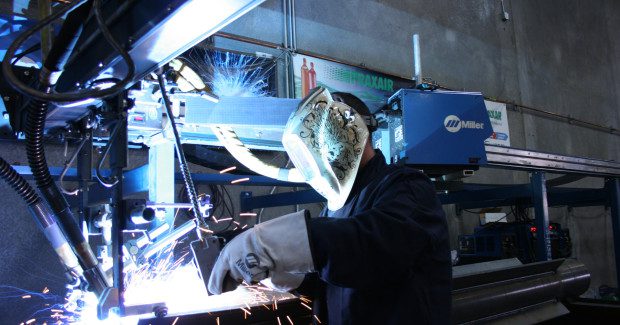Beyond the Robot: Improving Robotic Welding with the Right Filler Metal and Packaging
To achieve the full benefits of robotic welding, it’s important to focus on the entire system — not just the robot and power source. While a small part of a much bigger picture, the selected filler metal and its packaging can both play a critical role in maximizing the performance of a robotic welding system. Here’s how.
Posted: September 30, 2013
More and more, companies — large and small — are turning to robotic welding to gain improvements that can provide them with a competitive edge. That’s not suprising. When implemented correctly, robotic welding systems can offer an excellent return on investment, particularly in terms of increased productivity, greater cost savings and improved quality.
To achieve these benefits though, it’s important to focus on the entire system — not just the robot and power source. While a small part of a much bigger picture, the selected filler metal and its packaging can both play a critical role in maximizing the performance of a robotic welding system. Here’s how.
THE WELDING WIRE
Robotic welding involves very precise tolerances, making the exact placement of the filler metal or welding wire in the weld joint an important part of gaining good results. Even minute variations in how the wire feeds from the drum to the arc and into the joint can result in poor quality welds.
Tri-Mark Matrix is a premium metal-cored welding wire designed for automated applications. This wire is produced using a proprietary manufacturing process that has been designed from the ground up with consistency in mind. The result of this process is a welding wire that has unparalleled feeding characteristics. This video uses a “worst-case scenario” to show the excellent feedability of Tri-Mark Matrix when compared to a standard metal-cored wire.
For that reason, it is important to choose a wire that feeds smoothly through the drive rolls and liner without wandering. Wires engineered specifically for robotic applications are available in the marketplace to help.
Due to the manufacturing process they undergo, these wires are exceptionally consistent in their diameters and surface finish, and also possess smooth, reliable feeding characteristics. These attributes contribute positively to the repeatable welding performance needed in an automated application — robots gain their biggest productivity enhancements by quickly and efficiently performing the same welds over and over again.
When choosing a wire for a robotic welding application, it is also critical to find a product that produces consistent arc starts. This consistency can help eliminate weld defects, like cold lap and “wire wiskers” at the start of the weld, that could lead to downtime for rework upstream in the welding operation.
For many robotic welding applications, a metal-cored wire is an excellent choice to gain the wire feeding and arc starting consistency needed for the application. This type of tubular wire works well in robotic welding because of its mechanical properties, bead appearance and travel speeds. Also, the wire contains deoxidizers and other arc stabilizers in the core, which minimizes spatter production and in turn, reduces post-weld cleanup and lessens the frequency of robotic MIG gun cleaning, too.
The right metal-cored wire can also reduce instances of porosity commonly caused by contamination or protective coatings. That reduction is particularly important in applications in the automotive industry where robotic welding on thin gauge galvanized steel is prevalent.
New metal-cored wires carrying the AWS classification E70C-GS are a good choice for such applications. These wires operate with a direct current electrode negative (DCEN) or straight polarity, which results in a softer arc penetration that can help prevent burn-through and improve the penetration profile. The wires also offer sufficient arc energy to vaporize the galvanized zinc coating on this material, which helps drastically minimize porosity in the subsurface of the weld and on its surface, too.
These wires excel in their welding performance when paired with a Pulsed MIG or an optimized Pulsed MIG/MAG process.
Metal-cored wires are also available for materials found in other robotic welding applications and industries. And while this type of wire won’t always be the right solution, working with a robotic welding expert, wire manufacturer or trusted welding distributor can help companies decide.
THE FILLER METAL PACKAGE
In addition to the proper wire selection, choosing the right filler metal package is important to maintaining the uptime desired in a robotic welding application. In fact, reducing routine wire changeovers can be a very effective way of maximizing the return on investment in these applications.
The ideal filler metal package for a robotic welding application should be large enough to reduce wire changeovers as much as possible, yet not so large that the same wire sits on the shop floor for more than a few days. Filler metal for high usage robotic applications is usually shipped in drums or large reels, and once opened, it runs the risk of collecting dust, oil or other contaminants that can affect its welding performance. However, often these drums are used with a lid or cone top that assist in wire pay off and offer the added benefit of protecting the wire from contamination.
Package location is also important. In some cases, weld cell configurations make large filler metal drums impractical. When possible, however, stocking at least one extra filler metal package near the robot can help reduce downtime.
Finally, selecting recyclable filler metal packaging can reduce cost and downtime. They eliminate the need to separate and dispose of recyclable and non-recyclable packaging materials.
And remember, even though they are only a small part of the overall process, the filler metals and packages chosen for a robotic welding application are yet another means for companies to gain a solid return on their investment in automation.












